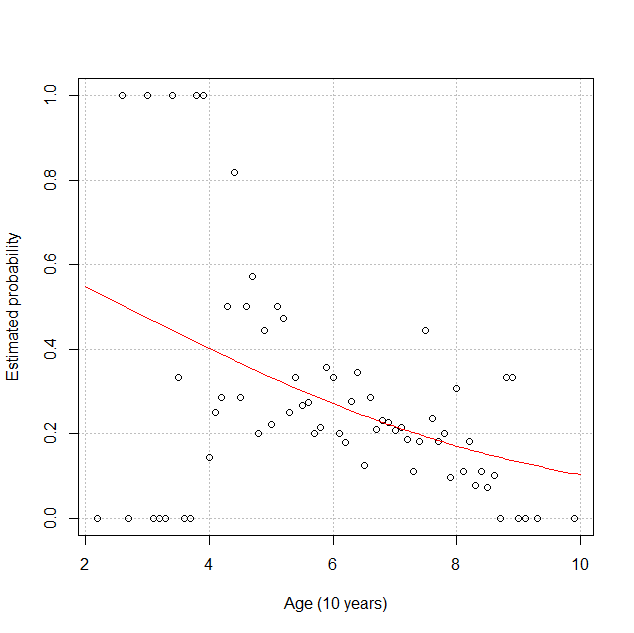| Table of Contents |
|---|
I. Welcome Video |
II. Course Overview at a Glance |
III. Course Objectives |
IV. Course Description |
V. Tentative Schedule |
VI. Sample Lecture |
I. Welcome Video
Videos removed on print.
Jump to top
II. Course Overview at a Glance
| Time & Place | ONLINE, full Summer semester, 6/2/2025 - 7/28/2025 |
| Instructor | Abdus Sattar, PhD |
| Office | Wood building: W-G51 |
| Teaching Assistant | Xueyi Zhang / Email: xxz586@case.edu |
| Office Hours | By appointment. Phone: 1-216-368-1501, Email: sattar@case.edu |
| Course Web Page | canvas.case.edu |
| Textbook (Required) | Analysis of Categorical Data with R by C. Bilder and T. Loughin |
Prerequisites:
|
|
II. Course Objectives
- Gain proficiency, specifically, in logistic regression, and broadly, in generalized linear models
- Acquire competency in standard and cutting edge categorical data analysis methods
- Hone skills by applying categorical data analysis methods in analyzing data
III. Course Description
Categorical data are often encountered in many disciplines including the fields of clinical and biological sciences. Analysis methods for categorical data are different from the analysis methods for continuous data. There is a rich collection of methods for categorical data analysis. The elegant “odds ratio” interpretation associated with categorical data is a unique one. This online course will cover cross-sectional categorical data analysis theories and methods. From this course, students will learn standard categorical data analysis methods and its applications to the biomedical and clinical studies. This particular course will focus mostly on statistical methods for categorical data analysis arising from various fields of studies including clinical studies; those who take it will come from a wide variety of disciplines. The course will include video lectures, group discussion and brainstorming, homework, simulations, and collaborative projects on real and realistic problems in human health tied directly to the student’s own professional interests. Focus will be given to logistic regression methods. Topics include (but are not limited to) binary response, multicategory response, count response, model selection and evaluation, exact inference, Bayesian methods for categorical data, and supervised statistical learning methods. This course stresses how the core statistical principles, computing tools, and visualization strategies are used to address complex scientific aims powerfully and efficiently, and to communicate those findings effectively to researchers who may have little or no experience in these methods.
Example: Analyzing Cancer Survivors’ Emotional Concerns
IV. Tentative Schedule
| Week | Chapters & Sections | Topics | Video/Slides |
|---|---|---|---|
| 1 | Introduction to categorical data analysis (CDA) | Introduction | |
| Chapter 1: Introduction to a Binary Response Analysis | |||
| 1.1.2 | One-binary variable | Point Estimation | |
| 1.1.2, 1.1.3 | One binary variable | Confidence Interval | |
| 1.1.2 | One binary variable | Hypothesis Test | |
| 1.2.1 | Two binary variables | Two Binary Variables | |
| 1.2.2, 1.2.3 | Two binary variables | Difference in Proportions | |
| 1.2.4 | Two binary variables | Relative Risk | |
| 1.2.5 | Two binary variables | Odds Ratio | |
| 2 | Chapter 2: Regression Models for a Binary Response | ||
| 2.1 | Introduction | ||
| 2.2 | Logistic regression models | Logistic Regression Model | |
| 2.2.1 | Logistic regression models | Parameter Estimation | |
| 2.2.2 | Logistic regression models | Hypothesis testing | |
| 2.2.2 | Logistic regression models | Deviance | |
| 2.2.3 | Logistic regression models | Odds Ratio | |
| 2.2.4 | Logistic regression models | Probabilities | |
| 2.2.5 | Logistic regression models | Interactions | |
| 2.2.5 | Logistic regression models | Quadratic Terms | |
| 2.3 | Generalized linear models | GLM | |
| 3 | Chapter 3: Analyzing a Multicategory Response | ||
| 3.1 | Multinomial Probability Distribution | ||
| 3.2.1, 3.2.2 | IxJ contingency tables & inference procedures | I X J Contingency Table | |
| 3.2.3 | IxJ contingency tables and inference procedures | I X J Independence | |
| 3.3 | Nominal response regression models | Nominal Response Models | |
| 3.4.1, 3.4.2 | Nominal response regression models | Ordinal Response Models | |
| 3.4.3 | Non-proportional odds model | Non-Proportional Odds Models | |
| 4 | Chapter 4: Analyzing a Count Response | ||
| 4.1 | Poisson distribution, Poisson likelihood & inference | Poisson Model for Count Data | |
| 4.2.1, 4.2.2 | Parameter estimation & inference | Poisson Regression Models I | |
| 4.2.3, 4.2.4 | Model interpretation, Categorical explanatory variables | Poisson Regression Models II | |
| 4.3, 4.4 | Other topics on analyzing a count response | Poisson Rate Regression & Zero Inflation | |
| 5 | Chapter 5: Model Selection and Evaluation | ||
| 5.1 | Variable Selection | ||
| 5.2.1 | Tools to access model fit | Residuals | |
| 5.2.2, 5.2.3 | Tools to access model fit | Goodness of Fit & Influence | |
| 5.3 | Over-Dispersion | Detection & Solutions | |
| Potential Project Topics | |||
| 6-8 | 6.1 | Binary responses and testing error | Completed Project Submission Deadline: 7/28/2025 |
| 6.1 | Binary response & testing error | ||
| 6.2 | Exact inference | ||
| 6.3 | Complex survey data analysis | ||
| 6.4 | “Choose all that apply” data | ||
| 6.5 | Categorical longitudinal data | ||
| 6.6 | Bayesian methods for categorical data | ||
VI. Sample Lecture
Videos removed on print.
Jump to top
Materials
PDF preview removed on print.
Jump to top

